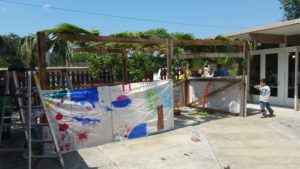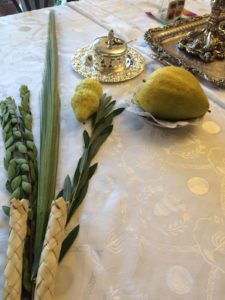Five days after the Day of Atonement (Yom Kippur), we celebrate with joy the Festival of Booths, known as Sukkot, that is, on Tishri 15. This is such a turn of emotional events as Yom Kippur is the most somber of the Holidays, and Sukkot could easily be the most joyous festival.
Sukkot was one of three festivals which required a pilgrimage to Jerusalem before the destruction of the second Temple, as commanded by G-d in the other two being Shavuot and Pesach, Twice, G-d commands this festival, one in Exodus 34:22 calling it the Festival of the Ingathering, marking the end of harvest time. Shavuot is also mentioned in this line. The second time, in Leviticus 23:33-44, G-d goes into more detail and commands us to celebrate for seven days and live inside sukkot, or sukkahs (sukkot is the plural of sukkah, and sukkah means booth or hut). Aside from giving thanks for a generous yield, we also commemorate the exodus from Egypt.
Today, we cannot go on pilgrimage to the Temple, so we honor this commandment both at home and at the synagogue. The two main symbols of observing Sukkot are the building of a sukkah, and the lulav and etrog.
The Sukkah
 The sukkah is a booth that must be put together each year at the beginning of the festival (Tishri 15). The walls of the sukkah may be made of any material available, and must be strong enough not to come down with any ordinary wind. Some people build the frame and use sheets for walls, it’s OK; others use lattice panels, or plywood, the materials are countless. We are commanded to live in it, eat in it, and welcome visitors for the duration of the festival.
The sukkah is a booth that must be put together each year at the beginning of the festival (Tishri 15). The walls of the sukkah may be made of any material available, and must be strong enough not to come down with any ordinary wind. Some people build the frame and use sheets for walls, it’s OK; others use lattice panels, or plywood, the materials are countless. We are commanded to live in it, eat in it, and welcome visitors for the duration of the festival.
A lot of observant Jews follow this commandment as closely as possible, whereas some people fulfill this commandment by eating some of the daily meals in it and perhaps taking naps or resting in it. Friends are always welcome. The job of the adults is mainly to build the sukkah, and the minors’ job is to decorate it with drawings and pretty hanging ornaments, although just about everyone joins in the fun equally. The sukkah, though found in many different sizes and formats, must follow certain rules of construction such as it cannot be under a tree that gives shade to it, for example.
The Four Species (Arba Minim)
 A palm frond, called a “lulav,” three myrtle branches, two willow branches, and an etrog (a citrus fruit) are called the Arba Minim. The three different types of branches are put together to form a sort of bouquet. The etrog is then held together with the branches and it is waved up and down, left and right, back and forth saying a blessing to celebrate Sukkot in the prescribed manner. This is done all seven days of Sukkot.
A palm frond, called a “lulav,” three myrtle branches, two willow branches, and an etrog (a citrus fruit) are called the Arba Minim. The three different types of branches are put together to form a sort of bouquet. The etrog is then held together with the branches and it is waved up and down, left and right, back and forth saying a blessing to celebrate Sukkot in the prescribed manner. This is done all seven days of Sukkot.
The day following Sukkot, on the eighth day we celebrate the holiday of Shemini Atzeret, or the Assembly of the Eighth Day, which is a holiday in its own, and traditionally has the belief that even though Sukkot has ended, G-d wants us to stay one day more to celebrate with Him in a more intimate way, like the host who stays at the end of a party with his special friends after everyone else has gone home.
